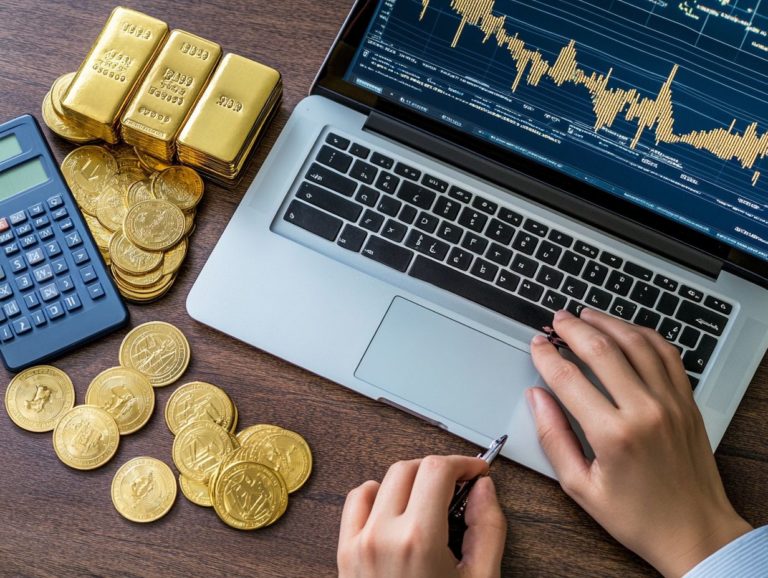10 Questions to Ask Before Investing in Gold
Investing in gold has always been a trusted method for diversifying your portfolio and safeguarding against economic uncertainty.
Navigating this landscape requires wisdom and strategy. This article reveals ten essential questions that will transform your gold investment approach.
From grasping the different types of gold investments and their associated benefits to acknowledging potential risks and market fluctuations, you ll be guided through the essential aspects of a sound gold investment strategy.
Whether you re just starting out or have years of experience, these insights will empower you to make informed decisions and elevate your investment journey.
Contents
- Key Takeaways:
- 1. What Are the Different Types of Gold Investments?
- 2. Why Should You Invest in Gold?
- 3. What Are the Risks of Investing in Gold?
- 4. How Does the Price of Gold Fluctuate?
- 5. What Is the Best Way to Buy Gold?
- 6. How Can One Determine the Quality of Gold?
- 7. Are There Any Tax Implications for Investing in Gold?
- 8. How Much Should One Invest in Gold?
- 9. What Is the Best Time to Invest in Gold?
- 10. What Are the Alternatives to Investing in Gold?
- Is Gold a Safe Investment Option?
- Frequently Asked Questions
Key Takeaways:

- Consider the different types of gold investments available before making a decision.
- Understand the benefits and risks associated with investing in gold.
- Be aware of the potential tax implications and determine the best time to invest based on the market and personal financial goals.
1. What Are the Different Types of Gold Investments?
Gold investments present a diverse array of options, each tailored to meet your distinct preferences and strategies. Consider tangible assets like gold bars and coins. Also, think about financial instruments like ETFs. It s vital for you to grasp these possibilities for effective portfolio allocation.
Take gold coins, for instance investing in pieces like the American Gold Eagle or Canadian Maple Leaf not only offers a sense of tangible security but also the potential for numismatic value. On the flip side, gold bars, typically sourced from reputable dealers like Provident Metals, serve as a cost-effective investment route, boasting lower premiums over the spot price.
Then there are gold ETFs, which allow you to gain exposure to gold without the logistical headaches of storage and insurance. However, do keep in mind that they come with management fees and market risks. Understanding these nuances now will empower you to make informed decisions that could shape your financial future!
2. Why Should You Invest in Gold?
Investing in gold presents a wealth of benefits, including protection against inflation, a steadfast hedge for wealth preservation, and the potential for significant returns. This makes it an essential component of any sophisticated investment portfolio.
Historically, the value of gold has consistently surpassed inflation rates, establishing itself as a reliable store of value, particularly during times of economic uncertainty. Unlike paper currencies, which can easily lose their value due to shifting monetary policies, gold maintains its intrinsic worth over time. This enduring characteristic not only safeguards your wealth but also paves the way toward financial independence.
By allocating a portion of your assets to gold, you often discover a sense of stability amid market turbulence. Incorporating gold into your investment strategy can significantly enhance your long-term financial security and growth.
3. What Are the Risks of Investing in Gold?
Investing in gold can indeed be lucrative, but it s important to recognize the inherent risks involved. Market volatility, liquidity concerns, and the potential for scams make it essential for you to conduct thorough due diligence and grasp the implications of tax on profits when you sell.
Market fluctuations can dramatically impact gold s value, sometimes catching investors off guard with unexpected losses. You might also encounter liquidity issues, which can hinder your ability to sell assets at your preferred price or time.
The precious metals market is particularly susceptible to fraud, with counterfeit products and misleading sales tactics capable of tricking even the most vigilant buyers. Therefore, if you’re considering a gold investment, engaging in comprehensive research and seeking reputable financial advice is crucial. Utilizing resources for tracking gold investment trends can help ensure that you are well-informed about your options and the associated risks.
Start your gold investment journey today by doing your research and consulting with experts!
4. How Does the Price of Gold Fluctuate?
The price of gold changes based on market demand, inflation, and commodity prices. These shifts can impact your market decisions.
Economic indicators like employment rates and consumer spending shape how gold is viewed as a safe-haven asset. When geopolitical events arise like trade tensions or political instability the market can become quite volatile.
As tensions escalate or economies show weakness, demand for gold often spikes, reinforcing its status as a reliable store of value. Staying vigilant and adjusting your approach in response to domestic and international developments is essential.
5. What Is the Best Way to Buy Gold?
You can buy gold in various ways. Options include physical assets like investment-grade coins and bars or gold accounts.
Many investors choose exchange-traded funds (ETFs) that track gold prices. These funds offer a liquid investment, allowing you to avoid the hassle of physical handling. If you want to diversify further, retirement accounts like a self-directed IRA provide an excellent pathway for gold investment.
Understand secure storage options to protect your investment now! Whether you keep gold in your possession or use custodial services, ensuring its quality is key. Verify it through certificates of authenticity and rely on reputable dealers to enhance the value of your holdings.
6. How Can One Determine the Quality of Gold?

Check the quality of gold to ensure its value. Look for purity certificates and understand the difference between allocated and unallocated accounts.
You can rely on karat measurements to assess the amount of pure gold in an alloy. For example, 24 karats represents pure gold, while 18 karats indicates a purity of 75%.
These figures significantly affect market demand and resale potential. Possessing a certificate of authenticity enhances the credibility of your gold investment. Such certifications assure you of the metal’s origin and quality, enabling informed decisions.
By understanding these standards, you secure your investment journey and lay the groundwork for a robust overall investment strategy.
7. Are There Any Tax Implications for Investing in Gold?
Investing in gold has tax implications to consider. You may face capital gains tax when you sell, and retirement accounts offer tax advantages.
When you sell gold, be aware that if your profits exceed certain thresholds, capital gains taxes will apply, affecting your overall returns. Some retirement accounts, like IRAs, allow you to hold gold without immediate tax consequences, deferring potential taxes until withdrawals are made.
Being knowledgeable about different tax brackets is essential for strategic planning of your sales or transfers. Consider spreading transactions over multiple years to lessen tax burdens or exploring options like tax-loss harvesting to offset gains.
By leveraging these strategies, you can enhance your investment approach, ensuring effective management of tax implications.
8. How Much Should One Invest in Gold?
Determining how much to invest in gold requires careful portfolio allocation. You need to consider your risk tolerance, financial goals, and current market conditions to create a balanced investment strategy.
If you re an aggressive investor, you might allocate a smaller percentage around 5-10% to gold, aiming for higher returns from equities. Conversely, if you prefer a conservative approach, dedicating about 15-20% to gold can help hedge against market volatility.
As you approach retirement, prioritizing stability may lead you to increase your gold allocation. Your unique financial landscape influences your strategy; some may see gold as a safe haven in uncertain times, while others view it as a means to diversify their investments. This allows you to customize your portfolio to fit your specific needs.
9. What Is the Best Time to Invest in Gold?
Timing is crucial for investing in gold. The best moments often depend on market conditions, speculative trends, and economic indicators that signal changes in gold prices.
To navigate these complexities, you must analyze market trends and economic signals for potential price fluctuations. Examining historical gold price data can provide valuable insights for your timing strategies. For example, looking at how gold performed during economic downturns can reveal patterns that assist your investment decisions.
Monitoring interest rates, inflation, and geopolitical events can deepen your understanding of when the market favors gold investments. By synthesizing this information, you can identify the best entry and exit points, maximizing your returns in the often volatile realm of gold trading.
10. What Are the Alternatives to Investing in Gold?
While gold may be your preferred investment, consider several compelling alternatives. Precious metals like silver and platinum can enhance your portfolio, as can diversified options like ETFs for broader market exposure.
For instance, silver offers a lower entry point and substantial industrial demand, especially in technology and renewable energy sectors. This demand could drive up its value over time, making silver an attractive choice.
Platinum, being rarer than gold, can present unique advantages during certain economic cycles, with automotive demand heavily influencing its price.
Incorporating ETFs into your investment strategy allows for easy diversification. Investing in a basket of precious metals spreads the risk while capturing the potential upside. Blending these assets with gold can create a more resilient and strategic investment approach.
Is Gold a Safe Investment Option?
Many view gold as a safe investment, especially in times of financial uncertainty. However, understanding the associated risks and potential returns is crucial for achieving stability and growth in your portfolio.
This precious metal has drawn interest for centuries, acting as a hedge against inflation while preserving value over time. However, be mindful that market fluctuations driven by geopolitical tensions, currency changes, and shifting interest rates can significantly affect gold’s performance.
It s vital to consider these factors. While gold has historically fared well in uncertain climates, it can also be volatile.
As you seek security in your investments, weigh the historical advantages of gold against its inherent risks. Ensure your strategies align with your broader financial objectives.
Consider your own investment strategies and seek advice on investing in gold or its alternatives.
What Are the Factors That Affect the Price of Gold?

The price of gold is influenced by a myriad of factors, including market price fluctuations and inflation rates. It s essential for you, as an investor, to stay well-informed about these dynamics.
Additionally, the delicate balance of supply and demand plays a crucial role in gold pricing.
Beyond these primary influences, economic policies, interest rates, and geopolitical tensions significantly shape the gold market. For example, when central banks opt for low-interest rates to stimulate growth, the appeal of assets that don’t earn interest, like gold, tends to increase.
During periods of geopolitical unrest, such as conflicts or trade disputes, investors often seek refuge in gold as a reliable safe haven.
Historical trends reveal that during economic downturns or crises like the financial crash of 2008 gold prices typically surge due to heightened demand as a protective asset. By grasping these interconnected factors, you can enhance your ability to navigate the complexities of gold trading with greater confidence and efficacy.
How Can One Protect Their Gold Investment?
Protecting your gold investment is essential for maintaining its value. Act now! Secure your gold with reliable storage solutions, conduct risk assessments for fraud, and perform regular portfolio reviews to ensure optimal performance.
In today s fluctuating market, stay alert by evaluating the best storage options available. Allocated storage is a wise choice, as it ensures that your specific gold bars or coins are stored separately, significantly reducing the risk of theft or loss.
While unallocated storage might tempt you with lower fees, it carries additional risks that could jeopardize your investment.
Securing comprehensive insurance coverage is another crucial step to safeguard against unforeseen circumstances, giving you peace of mind.
Keep an eye on market trends through reputable sources, as these can influence your decisions on when to buy, sell, or hold. This proactive approach ultimately enhances the profitability of your investment in the long term.
What Are the Common Mistakes to Avoid When Investing in Gold?
You might find that many investors stumble into common pitfalls when it comes to gold investments, such as falling prey to scams, misinterpreting market trends, and overlooking the importance of diversification in their strategies.
This often arises from insufficient research and a limited grasp of the commodities market, which includes goods like gold, oil, and agricultural products. Such limitations can lead to misguided choices.
Relying exclusively on unverified sources or non-certified brokers could dramatically heighten your risks.
It s essential for you to stay well-informed about economic indicators and geopolitical events that can sway gold prices. By dedicating time to compare brokers and ensuring they are certified and reputable, you can greatly diminish the likelihood of encountering fraud.
Embrace a balanced portfolio that includes a mix of gold and other assets. This strategy will protect you from market volatility and bolster your long-term financial security.
What Are the Long-Term Prospects of Investing in Gold?
The long-term prospects of investing in gold look promising. Gold offers potential returns that can outpace inflation and contribute significantly to wealth preservation during uncertain economic times.
Historically, gold has proven to be a safe haven in periods of economic turmoil, highlighting its lasting appeal among savvy investors. Factors like inflation rates, interest rates, and geopolitical tensions typically drive demand for gold, making it one of the top reasons to invest in gold this year, and underscoring its essential role in a well-rounded investment portfolio.
Trends from previous decades show a clear pattern: when market volatility spikes, the value of gold often rises, reinforcing its reputation as a hedge against financial instability.
By analyzing current indicators and aligning them with sound investment strategies, you can make informed decisions about gold, positioning yourself to benefit from its potential upside in future market cycles.
Now is the perfect time to consider gold for your investment portfolio.
How Can One Choose the Right Gold Investment Strategy?
Choosing the right gold investment strategy is crucial. Consider your financial goals and risk tolerance, along with the types of gold investments available, like investment-grade coins or ETFs.
It’s essential to take a close look at your current financial situation. Identify your financial resources and growth opportunities. Evaluating your short-term versus long-term objectives can significantly influence the strategy you choose.
For instance, while some investors may prefer a diversified approach that includes both physical gold and gold-related stocks to mitigate risks, others might carefully weigh the pros and cons of allocated versus unallocated gold holdings. Allocated gold means you own specific pieces, while unallocated gold allows easier access to cash since you share ownership with others. Understanding these options enables you to craft a balanced investment portfolio tailored to your specific needs, and considering 5 reasons gold should be in your portfolio can further enhance your strategy.
Frequently Asked Questions
What is gold and why is it a popular investment option?

Gold is a chemical element with the symbol Au and atomic number 79. It is a highly sought-after precious metal due to its durability, rarity, and resistance to corrosion. Gold has been used as a form of currency and a store of value for thousands of years, making it a popular investment choice for many.
What are the benefits of investing in gold?
Gold is considered a safe-haven asset, meaning it generally holds its value or increases during times of economic uncertainty. It can also provide diversification to a portfolio, as it typically has a low correlation with other assets such as stocks and bonds.
How do I invest in gold?
There are several ways to invest in gold:
- Buying physical gold such as coins or bars
- Purchasing gold jewelry
- Investing in gold stocks, ETFs, or mutual funds
Each method has its own advantages and considerations, so it’s important to research and understand your options before investing.
What are the risks associated with investing in gold?
As with any investment, there are risks involved in investing in gold. The value of gold can fluctuate, and it may not always increase over time. Be aware that storing physical gold can incur costs for storage and insurance. Selling gold may also have tax implications.
What are the factors that can affect the price of gold?
The price of gold can be influenced by various factors, including supply and demand, economic and political events, inflation, interest rates, and the strength of the US dollar. Stay informed and be aware of these factors when investing in gold.
Is investing in gold suitable for everyone?
Investing in gold may be suitable for some individuals, but it is not a one-size-fits-all solution. Take charge of your financial future! Assess your goals and risk tolerance to see if gold investment is the perfect fit for you. Consulting with a financial advisor can also help determine if it aligns with your overall investment strategy.














